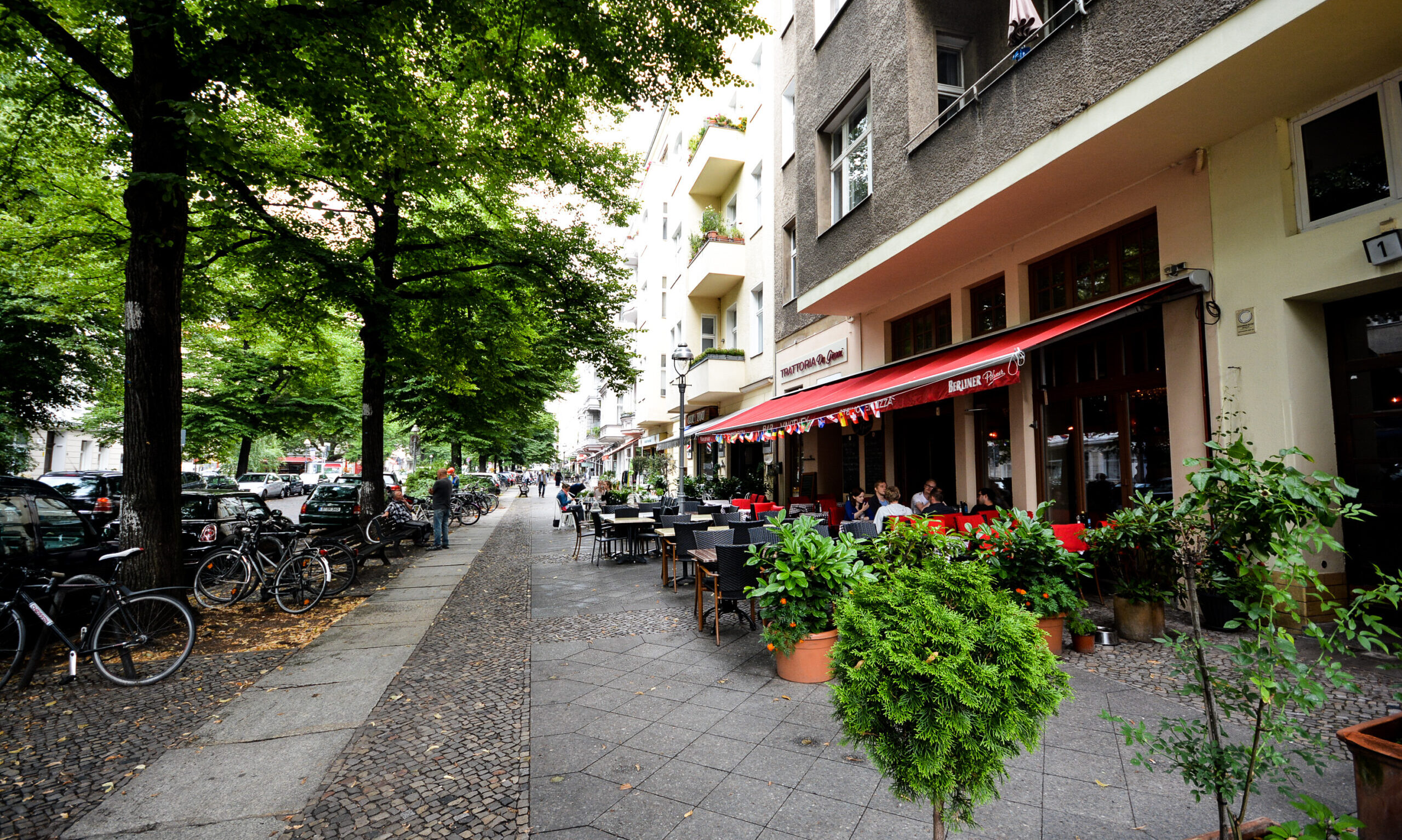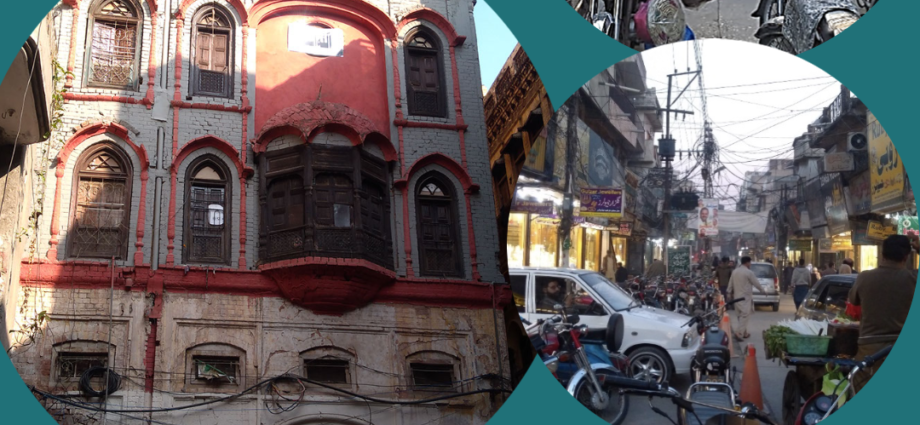By Samna Sadaf Khan
Project Location: Streets of Raja Bazaar, A historic market in the core of the city, Rawalpindi, Pakistan
Raja Bazaar, a historic market, lies in the heart of Rawalpindi as an urban center accommodating a great section of mercantile as well as residences. Mixed-use activity, density, street food, colonial and pre-colonial architecture and religious architecture followed by congestion, visual clutter, low livability and lost heritage are the key attributes of the area. A team of urban planners, architects, transport planner, economists and community mobilisers are conducting research and active projects in the Raja Bazaar area to identify urban challenges of public space, analyze mobility solutions and a derive a strategy towards pedestrianization.
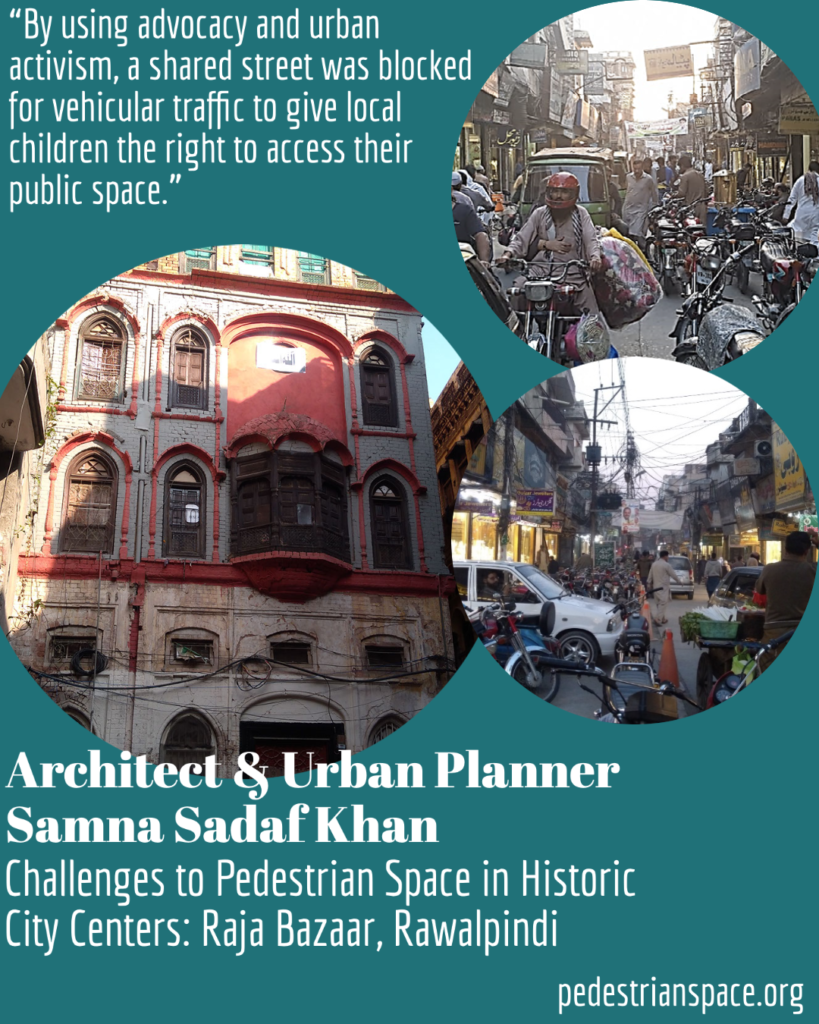
Description:
Historic city centers were built in an era when cars were not present; hence, the old streets embody a human scale to them. The street width fosters interaction; activities stimulate sensory experiences while the flexible and organic layout builds the element of discovery. Walking and non-motorized modes of transport were the only means of accessibility. At present, motorized vehicles have invaded the streets to an extent that the concept of ‘shared street’ has failed with the least right of way given to the pedestrians. This challenge is explored in the case of Raja Bazaar, historic market in the center of Rawalpindi.

Raja Bazaar accommodates mixed-use activities with a great section of mercantile as well as residences. The bazaar (market neighbourhood) narrates the complex historical socioeconomic growth of the city with features such as narrow meandering galis (narrow street that could be as wide as one meter), slender houses, mixed-use activities, worship places and irregular open spaces within the density. It is an example of a historic city center that reflects unity among the citizen through their social and cultural structure, while contributing to the city’s economic strength.

The shared street is the only embodiment of public space in Raja Bazaar that proffers immediate urban experience and multiplicity of functions. They are quintessential public spaces with cultural, economic, social, religious and political functions. Temporary appropriation and event based transformation is the key determinant of keeping the culture and festivity alive in the neighbourhood.
There are historical townhouses and havelis (mansions) in the streets from colonial and pre-colonial times recalling the rich heritage of the subcontinent. The facades adorn the decorative detail of those times with wooden balconies looking over the streets. The bulk of the buildings date from early 19th c. to early 20th c, and some of their features are in a vulnerable state. There also exist a number of mosques, temples and gurduwara (place of worship for Sikh community), as the area has nurtured a diverse mix of religions and cultures in the past. The Bazaar also offers a variety of local and street food that is representative of the local tastes and flavors.
“The shared street, which serves as the major public space, is now dominated by vehicular traffic for mobility.”
Currently, the area is fraught with problems. High density, unplanned land use, traffic congestion, visual clutter, inefficient services infrastructure and degraded housing has depreciated the livability of the area. The shared street, which serves as the major public space, is now dominated by vehicular traffic for mobility. This has reduced the social and economic potential of the street. The residents are exasperated with the intensified vehicular traffic and incompatible commercial activity in some locations. Customers and tourist – when they go there at all – confront a public space that lacks the most basic urban amenities such as a walking path, drainage, benches, trees and lighting.
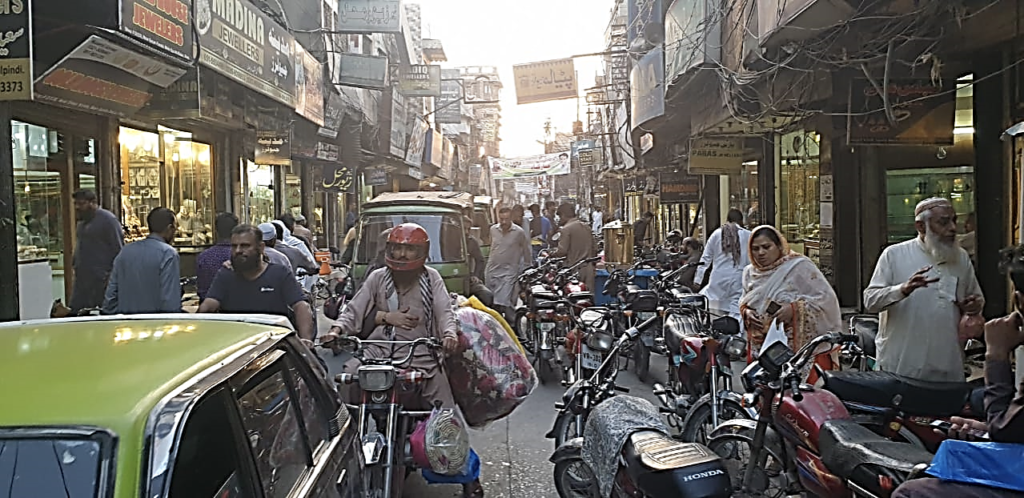
“The residents are exasperated with the intensified vehicular traffic and incompatible commercial activity in some locations. Customers and tourist – when they go there at all – confront a public space that lacks the most basic urban amenities such as a walking path, drainage, benches, trees and lighting.”
Raja Bazaar is referred as the place of chaos in local jargon rather than being signified as the historical center with tangible and intangible heritage and economic diversity.
A team of urban planners, architects, transport planner, economists and community mobilisers are conducting research in the Raja Bazaar area to identify urban challenges of public space and analyze solutions. Some members are a part of Urban Innovations, a consultancy firm for inclusive, livable and resilient urban environments while other individual professionals have joined under the umbrella of UNDP’s local Urban Platform to conduct research and provide advisory to the government.
The project components undertaken by the researchers are as follow:
- Street Regeneration of Bhabra-Sarafa Bazar market (one section in the whole area of Raja Bazar)
- Proposal of time based pedestrianization and food street in the Bhabra-Sarafa street
- Conservation of historical monument, Sujan Singh Haveli ( A historical mansion of a Sikh merchant in 1890s)
- Conservation of temples and historic homes in the area
- Mobility and Traffic Management Plan with residents, customer and traders survey
- Community mobilization to identify local champions. Meetings and focus group discussions are conducted to spread awareness about the projects, potential of tangible and intangible heritage as well as identify local problems.
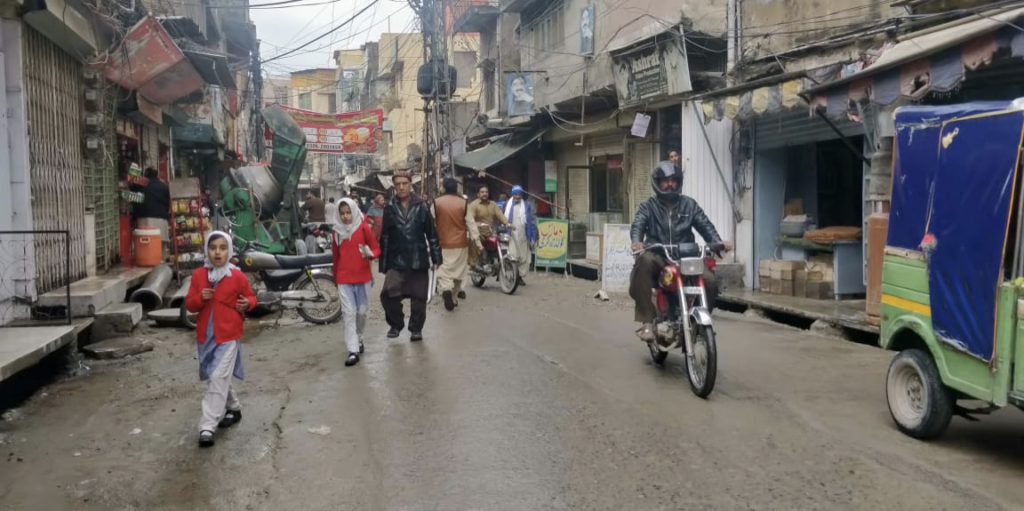
Traffic congestions is identified as the dominant challenge which hampers accessibility in the area, creates noise and air pollution, hampers movement, while deteriorating the urban quality and public space experience. Plummeting the vehicles with the aim of pedestrianization is like the ideal situation. However, the process towards the goal comes in conflict with the intricate real-time context.

Taking an example of Bhabra bazaar (a street in Raja Bazaar), researchers identified Motorbike workshops in one segment. The workshops emerged in the last decade owing to the rising number of ownership among the residents. Such shops hence require the entry of motorized vehicles. Blocking their entry would mean relocation of workshops and loss of livelihood to some extent. Another example is of the gold market, Sarafa Bazaar where customers arrive with a large sum of money. Private vehicles increase their sense of security as opposed to public transport and walking.
Density and the expanse of population in this limited space is a challenge. The houses are overcrowded with big family sizes. Visitors and workers add to the day population of Raja Bazaar. Attracting more visitors in the area can only be feasible after reclaiming the existing public space i.e. the street from the motorized vehicles.
“The aim of the Children Cycling event was to reclaim the street from the regular vehicles usage, and deliver a message of alternate practices.”
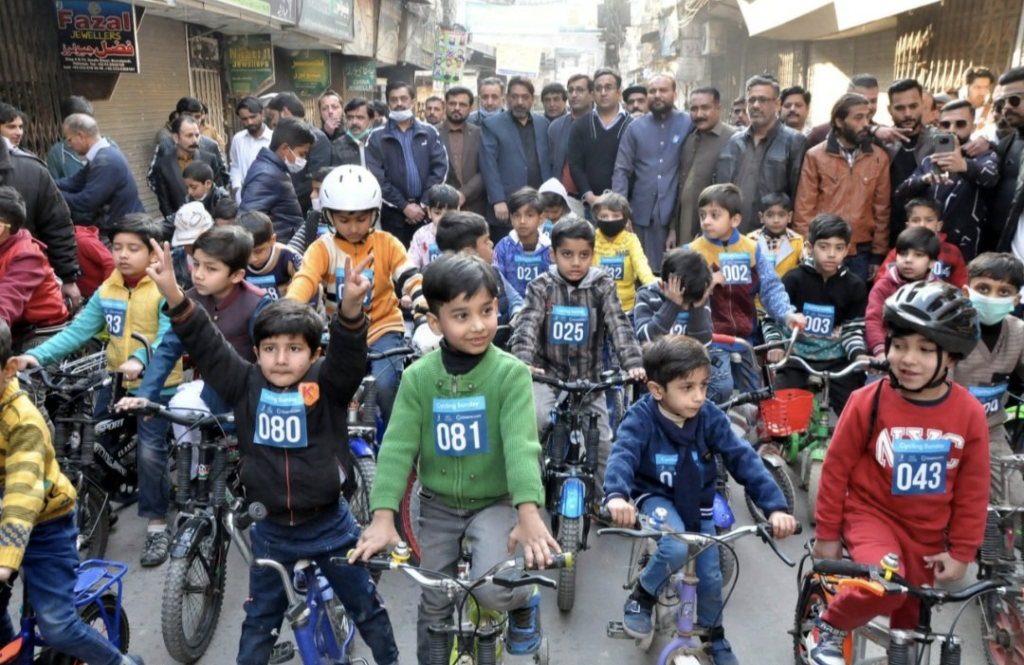
While the projects are in the research phase, the team took forward a social programming idea to reclaim the public space with the help of community leaders and Traders’ Association. Cycle races were conducted for children In the age group of 8-12 years. The street was blocked for vehicular traffic for a set duration of time with the support of government departments and traffic police. The aim of the Children Cycling event was to reclaim the street from the regular vehicles usage, and deliver a message of alternate practices. The event not only highlighted the interest and enthusiasm of children, it also raised the question of lack of public space for these local children. By using advocacy and urban activism, a shared street was blocked for vehicular traffic to give local children the right to access their public space.

“By using advocacy and urban activism, a shared street was blocked for vehicular traffic to give local children the right to access their public space.”
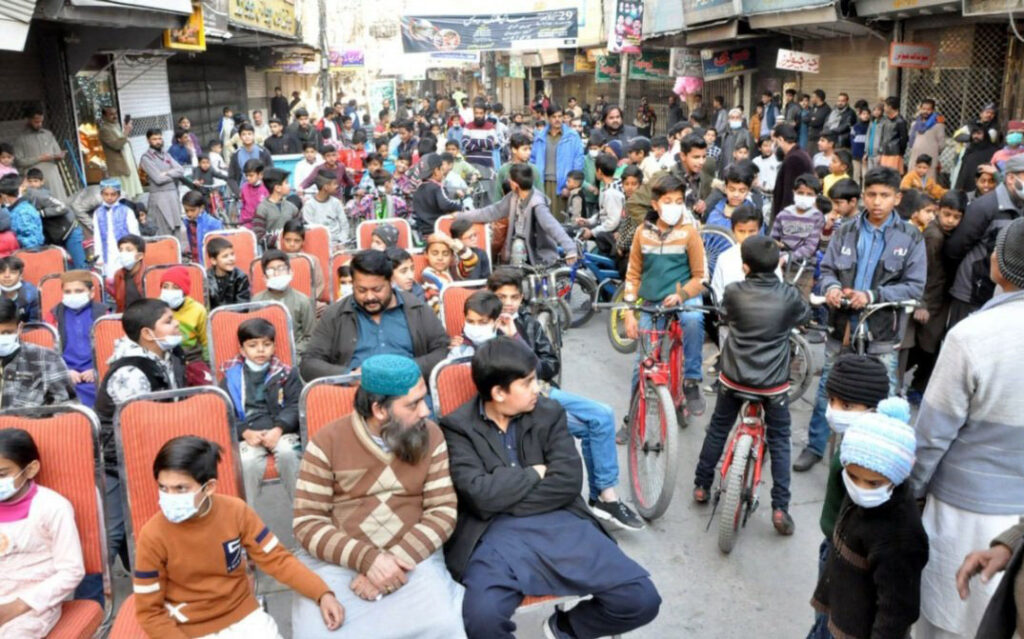
The street revival has become a challenge. The number of cars and motorbikes have increased drastically especially the latter due to their affordability for income groups in Raja Bazaar and accessibility in the narrow streets. With commercial activity comes freight delivery, some of which includes hand drawn carts. It becomes a challenge in the absence of set timings for freight delivery, resulting in traffic jams. There is a mix of fast and slow moving traffic with pedestrians laboring their way through it. There are limited decent public transport options available if one chooses not to visit Raja Bazaar in their car. In addition to the customers, residents and traders, there are passer-by vehicles as Raja Bazaar has a central location in the city.
“There is a dire need to have a behavioral shift program that promotes walking and use of public transport.”
The weak public transport system, and lack of inter modality in transport planning is a city level challenge reinforced from the research of Raja Bazaar. The culture of walking and cycling has diminished in the city, while the desire to own personal vehicles is the prevalent. Moreover, free parking on streets has worsened the space occupation by vehicles. Local authorities suggest building far-off parking plazas. However, with availability of free parking on street, parking plaza will have limited efficiency. The existing parking plaza has never been occupied to its potential due to the stated behavior in addition to its appalling design. Research in Raja Bazaar area has also highlighted the lack of public transport in the city of Rawalpindi. Thus, a mobility plan for Raja bazaar requires city level public transport changes as well as specific regulations in the area with regard to its historic relevance. There is a dire need to have a behavioral shift program that promotes walking and use of public transport.

The research into the mobility plans explored the feasibility of complete pedestrianization, vehicular traffic mixed with shuttle service and traffic routes in one-direction, to best meet the needs of residents, visitors and traders. While resolving the planning proposals, benefit of one merchant contradicts with the other. The complexity of circulation and behavioral patterns call for an arduous survey and planning to reach equitable solution for residents, customers and traders.
“The research into the mobility plans explored the feasibility of complete pedestrianization, vehicular traffic mixed with shuttle service and traffic routes in one-direction, to best meet the needs of residents, visitors and traders.”

Bottom-up approaches and community spirit are key features of the neighbourhood of Raja Bazaar for which the cycling event for children was a successful example. Therefore, the solutions also lie in the community through participatory approaches. A state and research led proposal will only be effective when the community will take ownership of the regulations.
“The crux of the entire economic, social, environmental, cultural and heritage tourism challenges lie in the solution of mobility.”
Up until now, the municipal authorities have blamed the traders for encroaching the public space on the street. The traders blame the residents for commuting at high speeds on their bike and the residents blame the incompatible commercial activity. It is imperative to crack the real problems before arriving at the mobility solution. The crux of the entire economic, social, environmental, cultural and heritage tourism challenges lie in the solution of mobility. The mobility plan for Raja Bazaar needs to minimize the number of vehicles, endorse public transport and alternate means to accessibility to the area, and promote non-motorized forms of transport such as cycling and walking. A historical city center can be truly explored through pedestrianization that is safe and inviting, henceforth allows the people walk, wander and stay in the public space.
The role of experts, thus, lies is understanding the complex dynamics of the area and mediating the conflicts to reach viable solutions. The revival of public space and pedestrianization is in the process while the challenges are yet a learning outcome.

Author’s Bio:
Samna Sadaf Khan is an Architect and Urban Researcher based in Pakistan. After practicing architecture for a couple of years in her country, she became more interested in urban design, public spaces and livability of cities. Consequently, she pursued her post-grad education in Urban Management and Development form Erasmus University, Rotterdam. Living and travelling in Europe, she developed a profound understanding of spatial structures in various countries in comparison to global south.
Her career objective lies within the balance of research, design and strategies for the livability and sustainability of urban environments. Currently she is working in Pakistan with Urban innovation, a consultancy firm that provides services to government, private sectors and international development organization regarding urban development, neighbourhood revitalization, heritage and cultural preservation, urban governance strategies, place making, and more.
Samna Sadaf Khan can be reached at Linkedin // Twitter: @sadafsamna
Urban Innovations Pvt. Ltd: http://www.urbinnovation.com Linkedin // Instagram: urban_innov // Twitter: @urban_innov
